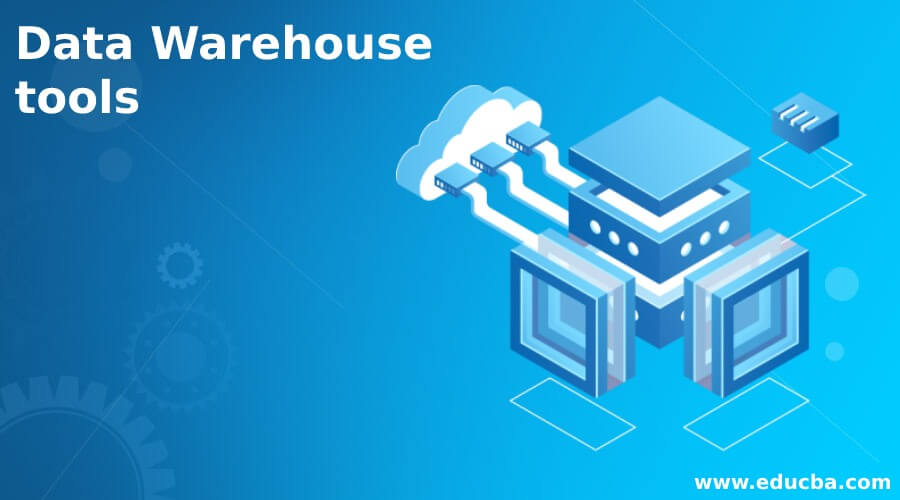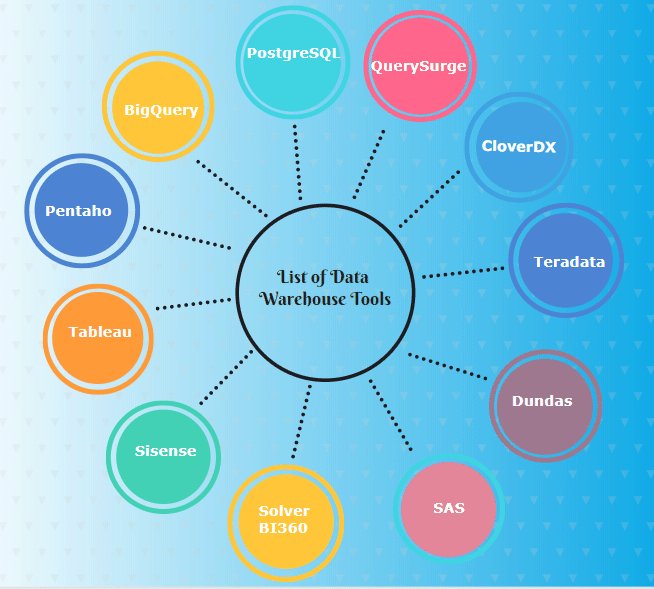Introduction to Data Warehouse Tools
The Data Warehouse tools are fundamentally used for various actions performed in a Data Warehouse, such as the process of Cleansing the data and segregating it from the junk or duplicate data, the process of ETL (Extracting, transforming & Loading) the data from various formats of sources into a single common format in the destination, the process of querying the data to fetch, update, delete or analysis the various combinations of data, the process of generating reports for analysis and essential business decision-making processes.
List of Data Warehouse Tools
- QuerySurge
- CloverDX
- Teradata
- Dundas
- SAS
- Sisense
- Tableau
- BigQuery
- PostgreSQL
- Pentaho
- Solver BI360
Let’s take a closer look at the Tools with their features in detail.
1. QuerySurge
QuerySurge is an RTTS-developed solution for ETL testing. It is specially designed to automate data storage and big data testing. It guarantees that in the target schemes, too, information obtained from sources remains intact.
Features of QuerySurge:
- These will improve data governance and data quality.
- The QuerySurge will accelerate data delivery cycles.
- Improve the quality of data and data governance.
- With this automation, manual testing becomes easy.
- It provides Testing on various platforms, such as Oracle, Amazon, IBM, Teradata, and Cloudera.
- It increases testing speed and provides information coverage by up to 100 percent.
- It includes a DevOps solution off-the-box for most construction, ETL, and QA software management.
- Provide shared, automated email reports and dashboards for information safety.
2. CloverDX
CloverDX is a data integration platform designed for people who need complete and thorough control over what they are doing, trying to fix complicated problems in intensive environments, and rather than developing their own, they will prefer to buy good-from-breed tools. It provides an interface with other external systems.
Features of CloverDX:
- Enjoy private assistance from CloverDX for company-grade.
- Host in the cloud or on-site, nodes or cluster nodes.
- Create extensible frames to save and share the cash with associates.
- Automating and orchestration of processes and transformations.
3. Teradata
Another Data warehouse tool is Teradata which is used for displaying and handling large quantities of information in the data warehouse. The organization boasts that the solution from Vantage is “the platform for Pervasive Data Intelligence” and “the software of its kind that manages all information constantly.” Vantage provides complete integration with many instruments and languages and leading analytical engines.
Features of Teradata:
- Teradata supports the SQL industry standard to interact with tables to store the data.
- The database system of Teradata is built on a solid parallel (MPP) architecture.
- Teradata System spreads the assignment between its procedures to ensure the task is finished promptly.
- Teradata can connect to systems connected to a channel like a mainframe or network-attached systems.
- Highly scalable are Teradata systems.
4. Dundas
It is a dashboard, analytics, and reporting tool. With Dundas, complete data transformation is possible. It provides features to create attractive data like charts, table styles, graphs, text formatting, etc.
Features of Dundas:
- Easy web browser access.
- Server application with complete product functions.
- Integrate and access every kind of data source.
- Intelligent tools for drag and drop.
- Can analyze Advanced and predictive data.
5. SAS
SAS is one of the large data warehouse tools that help users to access information from Different data sources. Analyzing big information with SAS makes it simple. SAS also provides data across organizations. Raw data files can be viewed in external databases, and information can be managed using different information tools, scientific graphs, and reports.
Features of SAS-
- In SAS, you can easily understand GUI.
- Easy and Ability to generate complicated models.
- Built-in knowledge base and the capacity to generate custom QKBs.
6. Sisense
Sisense is a business intelligence tool that analyzes and visualizes in real-time both large and disparate datasets. It is an ideal method for preparing complex information for dashboards with various displays.
Features of Sisense:
- Create a single truth version using smooth data.
- It allows you to create interactive dashboards without technology.
- Search for large data at high speed.
- Export data to Excel, CSV, PDF, and other formats Images.
- Handles information on a single commodity server on a scale.
- Filtering and calculating identify critical metrics.
7. Tableau
Many Business Intelligence industries use this tool for visualizing data. It helps to analyze complex data in a simple format. Data visualizations created with this tableau tool are in dashboards and worksheets. Anyone in the industry easily understands data created by the Tableau tool at any level. Even a non-technical, non-IT person without technology knowledge can understand this data.
Features of Tableau:
- Import all sizes and ranges information.
- It manages the metadata.
- Tableau Create a “no-code” data query.
8. BigQuery
BigQuery is a business-level, cloud-based data warehouse tool offered by Google. The platform is built to save time by storing and querying big datasets by providing super-fast SQL queries in seconds against multi-terabyte datasets, giving users real-time insights into data. Google BigQuery offers automatic information transfer and complete data access control.
Features Of BigQuery:
- A large number of data can be analyzed very quickly.
- Coding Skill is required in the BigQuery API.
- For Non-IT Users, it provides the Learning Curve.
- Pay as you go. Low cost.
9. PostgreSQL
PostgreSQL is an open-source, powerful object-related database system with more than 30 years of active growth that has earned it a strong reputation for reliability, robustness, and efficiency.
Features of PostgreSQL:
- PostgreSQL Supports the Backend.
- The Vendor does not provide PostgreSQL.
- PostgreSQL is extremely extensible about being free and open source.
- It helps developers to build applications, managers to protect data integrity and create fault-tolerant environments, and helps you manage your data no matter how large or small the dataset is.
10. Pentaho
Pentaho is open-source. This tool is not only used for data warehouse but also used in the business analysis process. It is designed for continuous innovation with its integrated, modern, embeddable, and future-organized analytics platform, including diverse and big data demands. The tool allows big data integration without coding, data visualization with personal dashboards, and a platform for data pipeline acceleration.
Features of Pentaho:
- Pentaho has an easy interface.
- Pentaho also has multiple tools.
- Quickly and easily analyze information from various sources by the Pentaho.
11. Solver BI360
Solver BI360 gives 360 data, reporting, data storage, and interactive Dashboards as part of the complete business intelligence platform. In the Data Explorer, users can readily view data and add sizes and modules.
Features of Solver BI360:
- Solver BI360 is very Flexible.
- They have great customer support.
Conclusion
In this article, we have seen a data warehouse and the software for data warehousing. Users can choose the best alternative tool based on the requirements, accuracy, and efficiency by comparing all the tools and software.
Recommended Articles
This has been a guide to Data Warehouse Tools. Here we discuss the introduction and the list of data warehouse tools with their respective features. You can also go through our other suggested articles to learn more –




